|
RETURN TO HOMEPAGE OF
WWW.THETENGU.COM/TENGU
Part I: What is a
Tengu?
We like to consider ourselves the biggest and best source
for tengu information...this may or may not be correct. But here is the
information we have gathered.

Tengu, crow-spirits, have been surrounded by an aura
of mystery and magic for centuries; they are connected with many circles
of influence, including Budo, Ninpo, Buddhism, Shintoism, natural magic
and chaos. It is important to note that while Tengu love to cause mischief
and confusion, they are never evil. They are connected to the
Japanese god of the sea and storms, Susanowo. He was the son of Izanagi
and Izanami, and the brother of the sun goddess Amaterasu, who became his
consort.
Varieties of Tengu
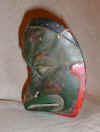 Tengu are generally described or envisioned as a bird-like
entity, taking on one form of several varieties. First there is the Karasu
Tengu, a winged bird-man who can harness the powers of nature These types
of tengu usually have a beak and seem more bird-like than man-like, and
they wear a cap on their head, and carry a sword or jo staff. The mask to
the left is an example of this sort of Tengu. Tengu are generally described or envisioned as a bird-like
entity, taking on one form of several varieties. First there is the Karasu
Tengu, a winged bird-man who can harness the powers of nature These types
of tengu usually have a beak and seem more bird-like than man-like, and
they wear a cap on their head, and carry a sword or jo staff. The mask to
the left is an example of this sort of Tengu.
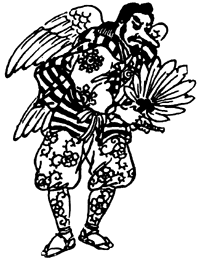 Then there is the Tengu variety with a human face and a beak-like
nose. These Tengu are the ones stereotyped by Buddhism as being
pride-fallen priests or warriors. They usually have a red face with a very
prominent nose which ranges in appearance from rediculous to beak-like.
They have, more often than not, a pair of wings and sometimes wear the
garb of a priest or samurai. The black and white image to the right is
this type of Tengu. Then there is the Tengu variety with a human face and a beak-like
nose. These Tengu are the ones stereotyped by Buddhism as being
pride-fallen priests or warriors. They usually have a red face with a very
prominent nose which ranges in appearance from rediculous to beak-like.
They have, more often than not, a pair of wings and sometimes wear the
garb of a priest or samurai. The black and white image to the right is
this type of Tengu.
 Lastly there is the Yamabushi Tengu, pictured with
Yoshitsune to the left, a Tengu disguised as a human mountain hermit or
priest, or possibly a great hermit sage who has become a Tengu through
meditation and exercises. This type of Tengu is the most potentially
dangerous, but also can be the most helpful. Tengu have been known to
impart valuable information about the martial arts among other things,
when they take this form. Lastly there is the Yamabushi Tengu, pictured with
Yoshitsune to the left, a Tengu disguised as a human mountain hermit or
priest, or possibly a great hermit sage who has become a Tengu through
meditation and exercises. This type of Tengu is the most potentially
dangerous, but also can be the most helpful. Tengu have been known to
impart valuable information about the martial arts among other things,
when they take this form.
All of the Tengu listed above may carry a special feather
fan that they use to stir up storms of any sort, as well as some buddhist
implements, like a staff with rings atop it, though Tengu existed long
before Buddhism ever reached the shores of Japan, and that is a long time!
Tengu have been known to cause trouble when their special place in
Shintoism as minor deities is threatened. Stories have been told of them
tormenting Buddhist priests (all in good fun) kidnapping children, and
generally causing alot of mischief. Tengu are known to be anthropomorphic,
meaning, they can change their shape at will. In some traditions, the
Kitsune (fox-spirit of Japan) is the same as a Tengu, in different shape.
While Tengu are usually male, Kitsune are usually female, but it is not
the rule. Perhaps the females prefer the fox shape, and the males the crow
shape. Tanuki (badger spirits) are also said to be a Tengu form.
Japanese culture was not always male-dominated. In the early formative
years of Nippon, the people were lead by tribal medicine women.
Sojobo
Sojobo is the king of Tengu, and is usually depicted as a
yamabushi with long white hair. He is said to have taught swordsmanship to
many of the clans in Japan, and lives in the high mountains, especially Mt
Kurama.
Tengu Powers And
Legend
The most interesting aspect of Tengu today is how their
reputation as martial artists and master swordsmen attracts the interest
of martial artists even today! It is thought that if you gain the favor of
a Tengu, they will grant you arcane knowledge of combat skills. A
paragraph from a very old document concerning Buddhist philosophy, I
believe from the very earliest times of Buddhism in Japan reads:
"In addition to this, there are other stories
such as Tenguyurashi, which tells of mountain huts shaking in the
middle of the night, and Tenguwarai, which tells of people hearing
sudden loud laughter during the night." This would all seem to point to
the conclusion that Tengu are nocturnal. It continues: "In the mountains,
there are trees where Tengu live. These trees are called Tengu
no tomarigi and we must not cut them down. Tengu's treasures
----- a magic cloak, a sedge hat, a small mallet Other names for
Tengu -----Guhin, Yamabito,
Yamanokami"
Tengu communicate via telepathy, and can also teleport to
wherever they like in the blink of an eye. They can move unseen and
unheard, and are also connected in myth to the ninja rebels of feudal
japan. It is said that the Tengu gave the secret to fighting the shogunate
to a man who started the first peasant uprising that gave birth to the
ninja, meaning, 'enduring man'.
Reportedly in 1860, to prepare the way for the Shogun's
visit to a sacred mausoleum, local authorities posted notices in all
seriousness ordering the Tengu of the district to relocate to a specified
mountain haunt until the Shogun had left.
Tengu are very curious and all Tengu are very knowledgeable
about almost everything.
Part II: Bird Spirits and Crow
in Other Cultures
Tien'Kou or Celestial/Heavenly
Dog
It has been mentioned time and again in other guides to
Tengu, that the chinese Tien'kou, or "celestial dog" is perhaps the
same as Tengu. I don't think they are the same exactly, but perhaps they
serve the same purpose. In his yang form, Tien'Kou helps the god Erh-lang
drive off evil spirits, however, during the night, he is yin, and his
energy is destructive and catastrophic. He was the meteor demon, causing
comets, eclipsing the sun by eating it, and also caused meteor showers.
The first appearance of Tien'kou was in the sixth century BCE, he came to
earth in comet with a long tail of fire. It poisoned all the crops and
water where it fell. It is said there is more than one Tien'kou, but only
one appears at a time. The Tien'kou appeared again in the second century,
in the shape of a shooting star. He is always accompanied by thunder.
Tien'Kou can be driven away with a bow made of mulberry wood, and an
amulet of dog hair.
Some of these descriptions of the Tien'Kou have prompted
some good people to conclude that the events are in fact alien
visitations, and Tengu are alien as well. Some of the attributes of Tengu
and Tien'kou do seem alien-like, such as the telepathic communication and
the loud thunder that accompanies the visitations of the celestial dog. I
myself believe that there are aliens, but I don't think Tengu are from
another planet.
Garuda
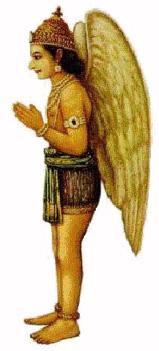 Garuda is the favored servant of Lord
Vishnu, one of the trinity of high-powered gods in Hindu theology. His
brave efforts and valor in rescuing his mother earned him immortality
gifted by Lord Vishnu. Garuda is the favored servant of Lord
Vishnu, one of the trinity of high-powered gods in Hindu theology. His
brave efforts and valor in rescuing his mother earned him immortality
gifted by Lord Vishnu.
He is identical in appearance to the Karasu type of Tengu,
and is depicted with a serpent or two in his claws, which he protects
against.
A tibetan form of Garuda is known of, but information on him
is obscure, however, I do have an amulet that depicts him looking just
like a tengu, but holding the serpents. The serpents may represent the
Kundalini, and the burning bite repercussions you can suffer from
awakening it prematurely.
The picture to the right is of Garuda. Notice the Indian
nose which is prominent and could possibly be mistaken for a Tengu nose.
Garuda is also shown in full bird form, as a parrot, swan or
crow.
Indians also once revered the crow as an animal who was
close to god, and they were often given food by people seeking help or
favor of the divine. Such customs have been largely forgotten today.
Egypt
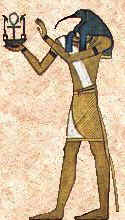 Pre-dating Japanese culture by more than
5,000 years, the egyptian gods have many attributes similar to Tengu, such
as long beaks (Tehuti, god of knowledge, wisdom and logic) feathery wings,
and feather patterns on their robes (Ptah,Aset,Sekhmet) Even some of the
gods, especially Ptah, have very chinese features. Even the pharoahic
beard resembles a tengu nose! This could be a red herring who knows, but
there are some interesting clues to be found within the egyptian mythology
and artwork. It awaits further exploration. Pre-dating Japanese culture by more than
5,000 years, the egyptian gods have many attributes similar to Tengu, such
as long beaks (Tehuti, god of knowledge, wisdom and logic) feathery wings,
and feather patterns on their robes (Ptah,Aset,Sekhmet) Even some of the
gods, especially Ptah, have very chinese features. Even the pharoahic
beard resembles a tengu nose! This could be a red herring who knows, but
there are some interesting clues to be found within the egyptian mythology
and artwork. It awaits further exploration.
Native American
Spirituality
 Kwekwaxa'we (or kwakiutl, pictured at
right) is the raven entity honored by the Northwestern tribes of America.
It was this raven spirit who freed the sun and the moon for all to enjoy,
and in other tribes, raven is the gatekeeper to the realm of magic, and a
powerful sorcerer. I must reiterate his magical abilities are extremely
great, and he is one of the most important figures to the northwest coast
indians. Kwekwaxa'we (or kwakiutl, pictured at
right) is the raven entity honored by the Northwestern tribes of America.
It was this raven spirit who freed the sun and the moon for all to enjoy,
and in other tribes, raven is the gatekeeper to the realm of magic, and a
powerful sorcerer. I must reiterate his magical abilities are extremely
great, and he is one of the most important figures to the northwest coast
indians.
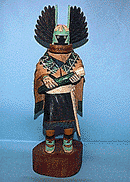  The Navajo, Hopi and Zuni tribes honor the spirits of nature
in the form of Kachinas, manifested in the form of small cottonwood dolls,
or as a dancer in the appropriate mask. There are almost a thousand
recognized Kachinas. The Navajo, Hopi and Zuni tribes honor the spirits of nature
in the form of Kachinas, manifested in the form of small cottonwood dolls,
or as a dancer in the appropriate mask. There are almost a thousand
recognized Kachinas.
There are several crow kachinas, the most important to us in
this subject is Angwusi, the crow, who is a whipping kachina, or a law
keeper. In the clown dances he watches the heyokahs or clowns as they try
their best to get a laugh out of everyone, and as their behavior gets more
and more outrageous the Angwusi will descend upon them and beat them
soundly for being so ridiculous. Together with owl and lizard he performs
this task.
Also of note are Angwusnasomtaqa (pictured above, right) and
Crow Bride kachinas, who are benevolent and do not behave in the same
manner as Angwusi, however Angwusnasomtaqa is the mother of all the
whipping kachinas.
At left is an example of an Angwusi Kachina, and a
particularily fine one at that, carved in the Hopi tradition out of one
piece of cottonwood. The markings are quite distinct , the four crosses on
the hem of his blanket, the winged bird face and the yucca canes held in a
threatening manner.
|